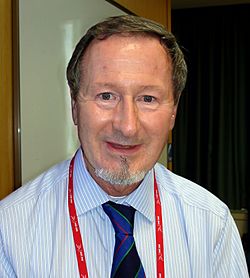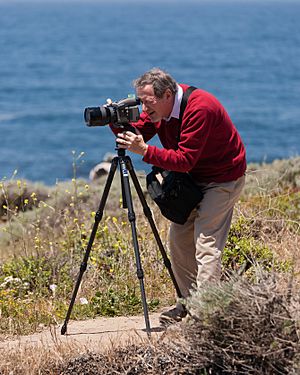Douglas Osheroff facts for kids
Quick facts for kids
Douglas Osheroff
|
|
|---|---|

Osheroff in 2011
|
|
| Born |
Douglas Dean Osheroff
August 1, 1945 Aberdeen, Washington, U.S.
|
| Alma mater | California Institute of Technology (B.S.), Cornell University (Ph.D.) |
| Known for | Discovering superfluidity in Helium-3 |
| Spouse(s) |
Phyllis Liu
(m. 1970) |
| Awards | Nobel Prize in Physics (1996) Simon Memorial Prize (1976) Buckley Prize (1981) MacArthur Fellowship Program (1981) |
| Scientific career | |
| Fields | Experimental Physics, Condensed Matter Physics |
| Institutions | Stanford University Bell Labs |
| Doctoral advisor | David Lee |
Douglas Dean Osheroff, born on August 1, 1945, is an American scientist. He is famous for his work in experimental physics, especially for helping discover something called "superfluidity" in a special type of helium called Helium-3. For this important discovery, he shared the Nobel Prize in Physics in 1996 with two other scientists, David Lee and Robert C. Richardson. Today, Osheroff is a retired professor of physics at Stanford University.
Contents
Life and Discoveries
Douglas Osheroff was born in Aberdeen, Washington. His father, William Osheroff, was the son of immigrants from Russia. His mother, Bessie Anne (Ondov), was a nurse whose parents were immigrants from Slovakia.
Osheroff attended the Lutheran Church when he was younger. Later, he chose not to attend church anymore. He has said that he believes in the idea of God but isn't sure how God would show himself.
Early Education and Research
Osheroff earned his first college degree in 1967 from Caltech. While there, he learned from famous scientists like Richard Feynman. He also did research as an undergraduate student for Gerry Neugebauer.
After Caltech, Osheroff went to Cornell University as a graduate student. He joined the Laboratory of Atomic and Solid State Physics. There, he focused on studying physics at very cold temperatures.
The Discovery of Superfluid Helium-3
At Cornell, Douglas Osheroff worked with David Lee, who led the lab, and Robert C. Richardson. They used a special device called a Pomeranchuk cooler to study Helium-3 at temperatures just a few thousandths of a degree above absolute zero. Absolute zero is the coldest possible temperature.
During their experiments, they noticed some unexpected things happening. They eventually figured out that these effects were caused by Helium-3 changing into a "superfluid" state. A superfluid is a special kind of fluid that has no friction or viscosity. This means it can flow forever without slowing down.
For this amazing discovery, Lee, Richardson, and Osheroff were jointly awarded the Nobel Prize in Physics in 1996.
Career After Cornell
Osheroff received his Ph.D. from Cornell University in 1973. After that, he worked at Bell Labs in New Jersey for 15 years. He continued his research into how materials behave at extremely low temperatures, especially Helium-3.
In 1987, he moved to Stanford University. He became a professor in the Departments of Physics and Applied Physics. He also served as the head of the physics department from 1993 to 1996. His research still focuses on what happens to materials when they are super cold.
Public Service and Hobbies
Osheroff was chosen to be part of the panel that investigated the Space Shuttle Columbia disaster. He played a similar role to what Richard Feynman did for the Space Shuttle Challenger disaster investigation.
He also serves on the board of advisors for Scientists and Engineers for America. This group works to encourage the use of good science in the American government.

Douglas Osheroff is left-handed. He sometimes jokes that his unique habits come from being left-handed. He loves photography and teaches students at Stanford about medium-format film photography. He has also taught introductory physics courses on electricity and magnetism, and labs on low-temperature physics.
Osheroff enjoys sharing his love for physics with others. He has participated in science festivals for middle and high school students. He was also a special guest at the International Young Physicists' Tournament in 2013.
He married Phyllis Liu-Osheroff, who is a biochemist, in 1970.
In May 2008, Osheroff was one of 20 American Nobel Prize winners in Physics who signed a letter to President George W. Bush. The letter asked for more funding for basic science research. They wanted to help the United States Department of Energy’s Office of Science, the National Science Foundation, and the National Institute of Standards and Technology.
Awards and Honors
- Nobel Prize in Physics (1996)
- Simon Memorial Prize (1976)
- Oliver E. Buckley Condensed Matter Prize (1981)
- MacArthur Fellowship Program (1981)
- Golden Plate Award of the American Academy of Achievement (1997)
See also
 In Spanish: Douglas Dean Osheroff para niños
In Spanish: Douglas Dean Osheroff para niños
- Timeline of low-temperature technology
- List of Jewish Nobel laureates

